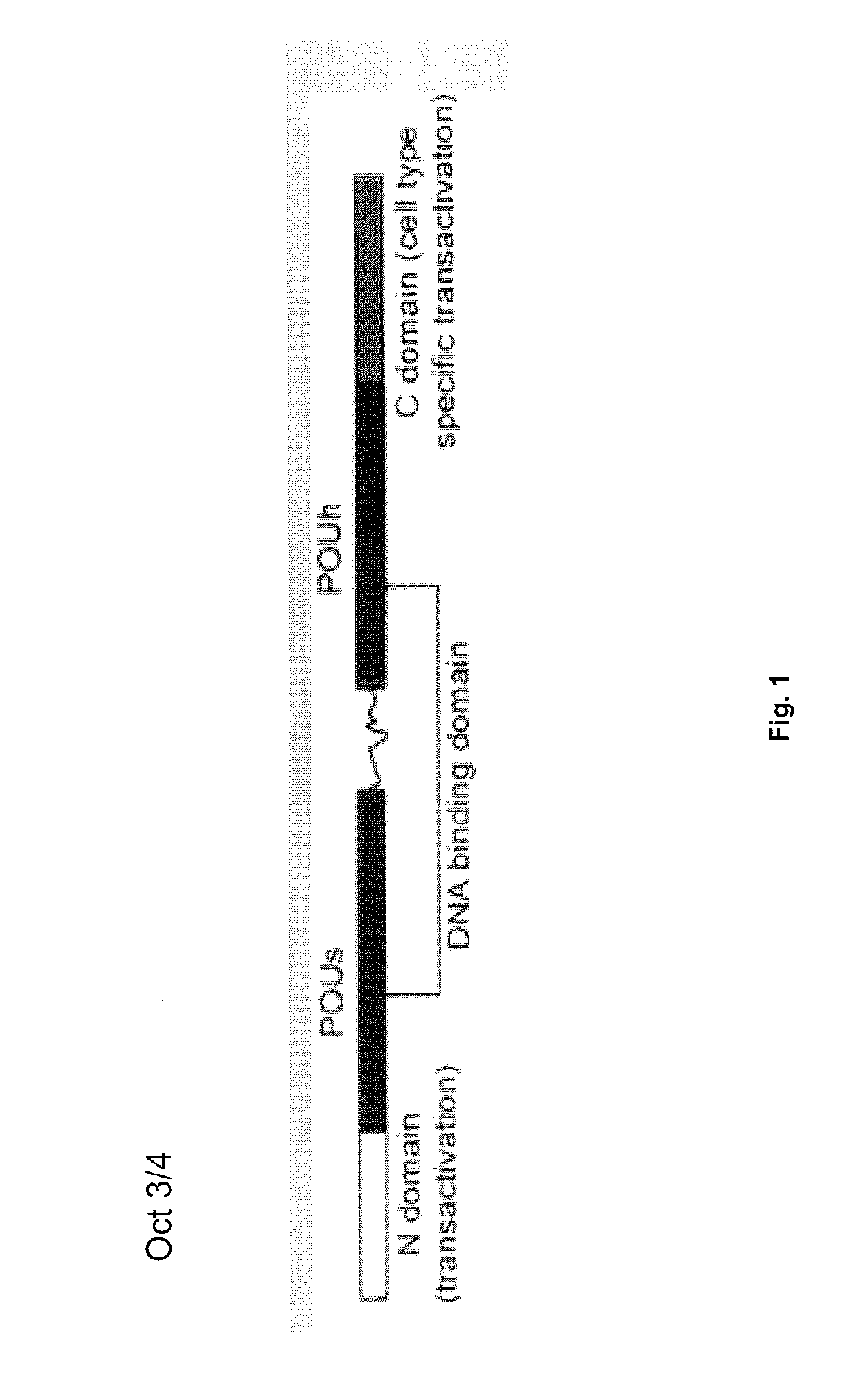De-differentiation of human cells
a human cell and dedifferentiation technology, applied in the field of dedifferentiation of human cells, can solve the problems of limiting the therapeutic application of either approach, affecting the therapeutic effect of either approach,
- Summary
- Abstract
- Description
- Claims
- Application Information
AI Technical Summary
Benefits of technology
Problems solved by technology
Method used
Image
Examples
example 1
Profect Protein Delivery
Reagents
[0099]Profect protein delivery reagents are available from Targeting Systems, El Cajon, Calif., accessible on the world-wide-web at targetingsystems.com. Profect-P1 is a lipid reagent that forms non-covalent complexes with proteins and enables translocation of intact functional proteins across the cell membrane. Profect-P2 is a non-lipid reagent that forms non-covalent complexes with proteins and enables protein transport across both the cell membrane as well as the nuclear membrane. Profect-P2 has endosomolytic properties which protect the internalized protein from being degraded in the lysosomes. Profect-P2 also has the unique ability to escort both DNA and protein across the nuclear membrane. Profect-P1 and Profect-P2 can form non-covalent complexes with a variety of proteins and can be used to successfully co-deliver different proteins. Proteins delivered with Profect range from 10 KDa to 540 KDa. Referring to FIG. 10, Intracellular protein delive...
example 2
Identification of Embryonic Stem Cell Markers in Induced Pluripotent Stem Cells by DNA Microarray Analysis
[0119]Using a genetic approach, induced pluripotent stem (iPS) cells were generated from adult human dermal fibroblasts (HDF) by retroviral-mediated transduction of four transcription factors, namely Oct3 / 4, Sox2, Klf4, and c-Myc (Takahashi K. et al. 2007 Cell 131:861-872). The human iPS cells were similar to human embryonic stem (ES) cells in morphology, proliferation, surface antigens, gene expression, epigenetic status of pluripotent cell-specific genes, and telomerase activity.
[0120]DNA microarray analyses showed that the global gene-expression patterns are similar, but not identical, between human iPS cells and hES cells. Among 32,266 genes analyzed, 5,107 genes showed more than 5-fold difference in expression between HDF and human iPS cells (See Tables S3 and S4 of Takahashi, K. et al. 2007, supra), whereas 6083 genes between HDF and hES cells showed >5-fold difference in ...
example 3
Identification of Candidate Reprogramming Factors
[0121]To identify candidate reprogramming factors, Yu et al. (2007 Science 318:1917-1920) compiled a list of genes with enriched expression in human ES cells relative to that of myeloid precursors and prioritized the list based on known involvement in the establishment or maintenance of pluripotency (Table 1). The investigators showed that, of these, four factors (Oct4, Sox2, Nanog and Lin28) were sufficient to reprogram human somatic cells to pluripotent stem cells that exhibit the essential characteristics of embryonic stem (ES) cells.
TABLE 1List of Human ES cell-enriched genesGeneAccession NumberPOU5F1 (Oct3 / 4)NM_002701NANOGNM_024865SOX2NM_003106FOXD3NM_012183UTF1NM_003577DPPA3NM_199286ZFP42NM_174900ZNF206NM_032805SOX15NM_006942PHBNM_002634MYBL2NM_002466LIN28NM_024674BCL2NM_000633DPPA2NM_138815DPPA4NM_018189DPPA5NM_001025290DNMT3BNM_006892DNMT3LNM_013369GBX2NM_001485TERF1NM_017489HESX1NM_003865SALL4NM_020436SALL1NM_002968SALL2NM_00...
PUM
 Login to View More
Login to View More Abstract
Description
Claims
Application Information
 Login to View More
Login to View More - R&D
- Intellectual Property
- Life Sciences
- Materials
- Tech Scout
- Unparalleled Data Quality
- Higher Quality Content
- 60% Fewer Hallucinations
Browse by: Latest US Patents, China's latest patents, Technical Efficacy Thesaurus, Application Domain, Technology Topic, Popular Technical Reports.
© 2025 PatSnap. All rights reserved.Legal|Privacy policy|Modern Slavery Act Transparency Statement|Sitemap|About US| Contact US: help@patsnap.com



